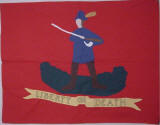 Hanover
Associaters
Hanover
AssociatersFlag of the Hanover Associations
Date: 1775.
Red field with soldier holding rifle. Inscription, "Liberty or Death". [R40]
The sentiment for Independence swept into York County in the summer of 1774. The Hanover Association of Volunteers resolved that "in the event of Great Britain attempting to force unjust laws upon us by the strength of arms, our cause we leave to Heaven and our rifles."
As early as July 4, 1774, York Countians selected a committee to protest British taxation. When Boston was blockaded as a result of its Boston Tea Party, York County provided financial help and militia. A local company of riflemen marched to Massachusetts. In 1775 there were 3,349 "associaters" or volunteer militiamen within the County, and by 1778, the count of York County militia was 4,621 of a total population at approximately 25,000. In 1779 Colonel Thomas Hartley observed that militia from York County may have been the first Pennsylvanians to arm and that they furnished more men for the war and lost a greater number of men than any other district of the same size.
To affirm their resolve the Hanover Association emblazoned a red flag with the slogan "Liberty or Death", and illustrated it with a rifleman prepared for either.
Today the flag exists only as an ancient engraving in the Pennsylvania State Archives.
Many Hanover area residents participated in the Revolutionary War.
"A military spirit had existed in Pennsylvania since the French and Indian Wars. Militia companies had responded from York County during this earlier conflict. The majority of men who composed these companies were hardy frontier types, skilled marksmen and hunters. Once their patriotism was rekindled with the news of happenings in New England, these individuals were quick to respond to the call of Congress and appeals of their countrymen.
"Hanoverians were some of the first to fight. Eight companies of Pennsylvania militia were to be formed. One of these was from York County. These early troops were responsible for clothing and equipping themselves. They managed to maintain somewhat of a uniform appearance by wearing white homespun frocks, commonly called "rifle frocks" and always carried the tea red "Pennsylvania Rifle". Their marksmanship was well known throughout the army at this time.
"Hanover's most famous military personage was Colonel Richard McAllister. He commanded the Second Pennsylvania Regiment which was part of what was called The "Flying Camp" was formed in the summer of 1776. Pennsylvania, Delaware and Maryland were to furnish troops for this organization. Pennsylvania was to supply six thousand men, four hundred were to come from York County.
"McAllister's regiment was composed of eight companies which were recruited from existing battalions of York County militia.
"McAllister commanded his regiment in the New York campaigns and at Staten Island where Washington's young army suffered a staggering defeat. Later McAllister's regiment took part in the defense of Fort Washington; here many of his troops were captured by the British and their German mercenaries.
"In 1777 McAllister's term of duty expired and he returned to York County to train and more effectively organize the County militias.
"Hanoverians also participated in the battles of Trenton, Princeton, Monmouth, Germantown, Brandywine and many others. In addition to the various York County militia battalions and McAllister's Second Pennsylvania Regiment, local men served in other Continental Regiments as well as Armand's Legion, Pulaski's Legion and the First Pennsylvania Rifle Regiment.
"Of equal importance was the role Hanover played in helping to supply Washington's army. Local farmers and merchants were instrumental in providing large amounts of raw foodstuffs, livestock and and clothing; many items that were so desperately needed, In 1778 by the authority of Congress, Hanover was appointed a sub-depot in the supply organization of the Continental Army. In April of 1780, the Hanover depot had supplies of 4,500 pounds of bacon, 4,500 pounds of pork, 10,000 pounds of flour, and 400 gallons of whiskey to be sent wherever needed."
Source: R. Vance Sheffer